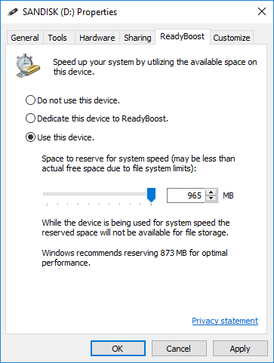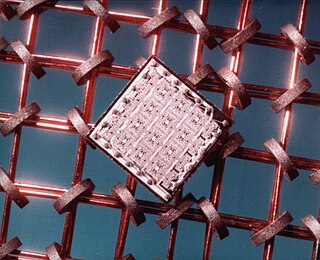Related Research Articles

Computer data storage or digital data storage is a technology consisting of computer components and recording media that are used to retain digital data. It is a core function and fundamental component of computers.

Computer memory stores information, such as data and programs, for immediate use in the computer. The term memory is often synonymous with the terms RAM,main memory or primary storage. Archaic synonyms for main memory include core and store.

Disk storage is a data storage mechanism based on a rotating disk. The recording employs various electronic, magnetic, optical, or mechanical changes to the disk's surface layer. A disk drive is a device implementing such a storage mechanism. Notable types are hard disk drives (HDD), containing one or more non-removable rigid platters; the floppy disk drive (FDD) and its removable floppy disk; and various optical disc drives (ODD) and associated optical disc media.

Random access is the ability to access an arbitrary element of a sequence in equal time or any datum from a population of addressable elements roughly as easily and efficiently as any other, no matter how many elements may be in the set. In computer science it is typically contrasted to sequential access which requires data to be retrieved in the order it was stored.

Sequential access is a term describing a group of elements being accessed in a predetermined, ordered sequence. It is the opposite of random access, the ability to access an arbitrary element of a sequence as easily and efficiently as any other at any time.

In computing, booting is the process of starting a computer as initiated via hardware such as a button on the computer or by a software command. After it is switched on, a computer's central processing unit (CPU) has no software in its main memory, so some process must load software into memory before it can be executed. This may be done by hardware or firmware in the CPU, or by a separate processor in the computer system.
A direct-access storage device (DASD) is a secondary storage device in which "each physical record has a discrete location and a unique address". The term was coined by IBM to describe devices that allowed random access to data, the main examples being drum memory and hard disk drives. Later, optical disc drives and flash memory units are also classified as DASD.
Non-volatile random-access memory (NVRAM) is random-access memory that retains data without applied power. This is in contrast to dynamic random-access memory (DRAM) and static random-access memory (SRAM), which both maintain data only for as long as power is applied, or forms of sequential-access memory such as magnetic tape, which cannot be randomly accessed but which retains data indefinitely without electric power.
In computing, mass storage refers to the storage of large amounts of data in a persisting and machine-readable fashion. In general, the term "mass" in "mass storage" is used to mean "large" in relation to contemporaneous hard disk drives, but it has also been used to mean "large" relative to the size of primary memory as for example with floppy disks on personal computers.

In computer data storage, data striping is the technique of segmenting logically sequential data, such as a file, so that consecutive segments are stored on different physical storage devices.
Non-volatile memory (NVM) or non-volatile storage is a type of computer memory that can retain stored information even after power is removed. In contrast, volatile memory needs constant power in order to retain data.

Magnetic storage or magnetic recording is the storage of data on a magnetized medium. Magnetic storage uses different patterns of magnetisation in a magnetizable material to store data and is a form of non-volatile memory. The information is accessed using one or more read/write heads.
Reading is an action performed by computers, to acquire data from a source and place it into their volatile memory for processing. Computers may read information from a variety of sources, such as magnetic storage, the Internet, or audio and video input ports. Reading is one of the core functions of a Turing machine.

In computer science, data is any sequence of one or more symbols; datum is a single symbol of data. Data requires interpretation to become information. Digital data is data that is represented using the binary number system of ones (1) and zeros (0), instead of analog representation. In modern (post-1960) computer systems, all data is digital.

ReadyBoost is a disk caching software component developed by Microsoft for Windows Vista and included in later versions of Windows. ReadyBoost enables NAND memory mass storage CompactFlash, SD card, and USB flash drive devices to be used as a cache between the hard drive and random access memory in an effort to increase computing performance. ReadyBoost relies on the SuperFetch and also adjusts its cache based on user activity. ReadyDrive for hybrid drives is implemented in a manner similar to ReadyBoost.
An access method is a function of a mainframe operating system that enables access to data on disk, tape or other external devices. Access methods were present in several mainframe operating systems since the late 1950s, under a variety of names; the name access method was introduced in 1963 in the IBM OS/360 operating system. Access methods provide an application programming interface (API) for programmers to transfer data to or from device, and could be compared to device drivers in non-mainframe operating systems, but typically provide a greater level of functionality.

Random-access memory is a form of electronic computer memory that can be read and changed in any order, typically used to store working data and machine code. A random-access memory device allows data items to be read or written in almost the same amount of time irrespective of the physical location of data inside the memory, in contrast with other direct-access data storage media, where the time required to read and write data items varies significantly depending on their physical locations on the recording medium, due to mechanical limitations such as media rotation speeds and arm movement.
This glossary of computer hardware terms is a list of definitions of terms and concepts related to computer hardware, i.e. the physical and structural components of computers, architectural issues, and peripheral devices.
bcache is a cache in the Linux kernel's block layer, which is used for accessing secondary storage devices. It allows one or more fast storage devices, such as flash-based solid-state drives (SSDs), to act as a cache for one or more slower storage devices, such as hard disk drives (HDDs); this effectively creates hybrid volumes and provides performance improvements.
Solid-state storage (SSS) is non-volatile computer storage that has no moving parts – uses only electronic circuits. This solid-state design dramatically differs from the commonly-used competing technology of electromechanical magnetic storage which uses moving media coated with magnetic material. Generally, SSS is much faster but more expensive for the same amount of storage.